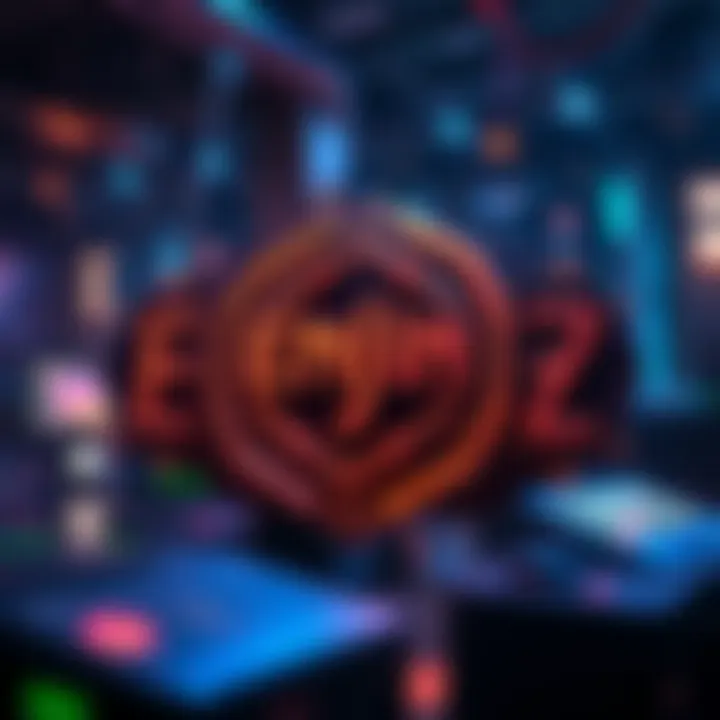Exploring Enjin: Innovations in Gaming and Blockchain


Intro
As the digital landscape evolves, the fusion of gaming and blockchain technology emerges as a focal point, reshaping how users interact with digital environments. Enjin stands at the forefront of this movement, and it’s worth taking a closer look at how this platform innovates within both realms. It offers various tools that allow game developers to integrate blockchain features smoothly and efficiently, highlighting the future of digital assets in real-time gaming.
In this exploration, we will navigate several pivotal aspects of Enjin, ranging from its core functionalities to the broader implications of its technology in today's market. By diving into Enjin’s ecosystem, we’ll uncover how it facilitates tokenization, enhances user experiences, and addresses security concerns in a rapidly changing Web3 environment.
Additionally, we’ll spotlight market insights and blockchain innovations, presenting a panoramic view of how Enjin not only adapts but also pushes the boundaries of current trends within the cryptocurrency space and the gaming sector. Ultimately, this discussion aims to provide valuable perspectives for investors, tech enthusiasts, and academics alike, who seek a deeper understanding of this revolutionary intersection.
Prolusion to Enjin
Understanding the intersection of gaming and blockchain technology is pivotal for recognizing the transformative potential within the gaming sector. Enjin stands at this nexus, offering innovative solutions that make it easier for developers and gamers alike to leverage digital assets. As the gaming industry continuously evolves, facilitated by advancements in technology, platforms like Enjin are carving new paths that could shape the future of interaction in digital spaces. This section sheds light on the fundamental aspects of Enjin, highlighting its role not just as a platform but as a framework that supports the burgeoning environment of blockchain-enabled gaming.
Background and Objective
Enjin was founded in 2009 with aspirations that extend well beyond creating a simple gaming platform. The vision was to revolutionize how games could function in an interconnected world, allowing for seamless transfer and integration of virtual items across multiple games. The concept of tokenization came to the forefront, where developers could create, manage, and trade digital assets that hold real value. By leveraging the Ethereum blockchain, Enjin took strides towards making these concepts a reality, providing tools that empower developers to create richer, more engaging gaming experiences.
The objective of Enjin reflects a commitment to enhancing the way players interact with their favorite titles. By utilizing blockchain technology, Enjin promotes the idea of true ownership of in-game assets, which is a significant shift from the traditional gaming models where ownership is typically an illusion governed by centralized servers. The project aims to ease the technical challenges often faced by developers, facilitating the incorporation of blockchain elements without a steep learning curve.
Purpose of the Article
This article serves as an informative guide for investors, tech enthusiasts, and academics who are keen on the evolving landscape of blockchain within gaming. It aims to break down Enjin's multifaceted ecosystem, exploring its functionalities, integrations with gaming, and its implications for user experience and security. By examining the innovations brought forth by Enjin, the content seeks to illuminate not merely the advantages of using the platform but also its broader significance in the context of Web3 technology.
In addition to providing insights into the technological capabilities of Enjin, the article will delve into the potential challenges and considerations developers must navigate in this fast-paced environment. With the continuous growth and adoption of blockchain technology, understanding Enjin's offerings can be invaluable for those looking to remain ahead in the gaming industry.
"Innovation in gaming is not just about better graphics or faster processing; it’s about creating meaningful experiences that resonate with players on a deeper level."
Through a detailed exploration of Enjin’s principles and components, readers are encouraged to grasp the transformative potential of merging gaming with blockchain technology, equipping them with knowledge relevant to both investment and development in this promising field.
What is Enjin?
Understanding what Enjin is holds significance not just within the tech realm but also for a broader audience keen on gaming innovations and blockchain systems. Enjin represents a melting pot of technology and creativity, allowing developers to create, manage, and integrate blockchain-based gaming assets easily. The platform enables the creation of a novel digital economy in gaming, thereby enhancing the experience for both developers and players. It’s crucial to delve deep into Enjin’s structure and features, as this understanding can directly correlate to how it might reshape the landscape of digital interactions in gaming.
Overview of the Enjin Platform
The Enjin platform operates as a comprehensive ecosystem tailored for the gaming world, with a major goal of simplifying the tokenization process. The backbone of Enjin is its powerful suite of tools designed for developers who wish to integrate blockchain technology into their games without needing a deep knowledge of coding or blockchain workings was often seen as a daunting task.
Enjin's approach to game development is like providing players with a treasure map, leading them to new and exciting realms of user engagement and asset ownership. Here’s a glimpse into its essential components:
- Enjin Coin (ENJ): The native cryptocurrency that fuels the ecosystem. This coin can be utilized in various gaming experiences, granting players ownership of digital assets.
- Enjin Wallet: This is not just a wallet but a secure vault where users can manage their virtual items, providing convenience and security in this digital age.
- Enjin Beam: This innovative tool allows developers to distribute tokens easily, enabling promotions and onboarding without hassle.
This multi-faceted approach not only defines what Enjin is but also provides the framework for understanding how it stands out among blockchain platforms. The accessibility it offers to developers is vital as it opens doors to new creative paths in game design and interaction.
Core Features of Enjin
Enjin is more than just a platform; it’s a catalyst for innovation in gaming. Its core features are essential to grasp in order to appreciate its impact fully. Here’s a breakdown of what makes Enjin unique:
- Tokenization: Enjin allows game developers to turn in-game items into blockchain-based assets. You can think of this as crafting unique, one-of-a-kind collectibles where transparency and ownership are guaranteed through blockchain technology.
- Interoperability: One of the remarkable aspects of Enjin is its ability to support different games and developers. Digital assets created on Enjin can be utilized across multiple games. This opens a universe of possibilities where gamers can trade, sell, or use their items in different contexts.
- Security: With the rise in digital asset ownership, concerns about security have also escalated. Enjin takes this seriously, implementing robust security measures to ensure users’ assets are safe and sound.
- User-Friendly Interface: A hallmark of Enjin's design is its focus on user experience. It makes navigating through the platform intuitive, removing the hurdles that often accompany technology interface.
- Community Engagement: Enjin fosters a strong community atmosphere where developers and gamers can collaborate. This engagement is crucial in finding synergistic solutions to emerging challenges in the digital space.
"Enjin is not just about gaming; it's about creating a sustainable economy where creativity thrives."
The Technology Behind Enjin
The technology that underpins Enjin is foundational to its success, acting as the backbone that supports the integration of blockchain into gaming. Enjin harnesses advanced blockchain principles to provide a seamless and efficient platform for both developers and players. As the gaming industry continues to evolve, understanding the technological elements that Enjin brings to the table is essential for anyone interested in the intersection of gaming and blockchain.
Blockchain Architecture
Enjin's blockchain architecture is designed for scalability, security, and flexibility. Unlike many blockchain systems that suffer from congestion and slow transaction times, Enjin aims to provide a robust environment capable of handling high throughput. This scalability is particularly vital when considering numerous in-game transactions, where speed and reliability are imperative.


The platform operates on the Ethereum blockchain, benefitting from its public nature while also implementing a layer that allows faster processing of transactions. By utilizing ERC-1155 tokens, Enjin enables developers to create a wide variety of digital assets without encountering the limitations of previous token standards.
- Interoperability: One of the standout features of Enjin is its ability to facilitate interoperability between different games and applications. This means that a sword earned in one game can be used in another. This cross-game compatibility enhances the overall player experience and provides a sense of true ownership.
- Decentralization: Enjin's architecture promotes a decentralized ecosystem where players are not just consumers but also stakeholders. The use of blockchain ensures that assets are verifiable, traceable, and secure.
As the industry progresses, Enjin's architecture stands ready to adapt. The ongoing development of layer-2 solutions and sidechains aims to further improve efficiency, ensuring that Enjin remains relevant and capable as the demands of the gaming world grow.
Smart Contracts and Their Applications
Smart contracts are at the heart of Enjin's operations, dictating how transactions are executed and automating processes that once required manual oversight. These self-executing contracts bring a range of benefits to both developers and users in the Enjin ecosystem.
- Automation of Transactions: Smart contracts eliminate the need for intermediaries in financial transactions. This not only reduces cost but also minimizes the time involved in processing each transaction. For gamers, this could mean faster trades for in-game items and quicker transaction confirmations.
- Customizable Game Mechanics: Developers can use smart contracts to create unique game mechanics. For example, a game could integrate a smart contract that automatically rewards players when they achieve certain milestones, directly enhancing user engagement and satisfaction.
Moreover, smart contracts bolster security by ensuring that transactions adhere to defined rules without the risk of tampering. This establishes trust within the gaming community, as players can verify that their assets are safeguarded from fraudulent activities.
"Smart contracts eliminate the intermediary, allowing trust to be placed in code rather than in people."
They also allow seamless integration with other decentralized applications, creating a ripple effect that extends beyond individual games, pulling the larger Enjin ecosystem into a cohesive unit designed for expansion. With Enjin leading the way, the potential applications of smart contracts in gaming appear limitless.
In confusion-laden territory of blockchain, Enjin's focus on playing to its technological strengths sets it apart. As it innovates, both players and developers benefit from an improved ecosystem that emphasizes speed, security, and flexibility.
Enjin Ecosystem and Components
The Enjin ecosystem is at the heart of what makes this platform distinctive in the worlds of gaming and blockchain. Enjin not only serves as a bridge between these two realms but also establishes a robust environment where developers and players alike can thrive through innovative applications and functionalities. An in-depth understanding of its components is essential for anyone looking to grasp the full potential of Enjin’s offerings.
Enjin Coin: The Native Cryptocurrency
Enjin Coin is the lifeblood of the Enjin ecosystem, designed specifically for enhancing the gaming experience. This native cryptocurrency serves multiple purposes, acting as a medium of exchange for in-game assets and rewarding users for their participation in the ecosystem. It's built on the Ethereum blockchain, ensuring a degree of security and adaptability that is vital in today’s technological climate.
- Utility in Transactions: Enjin Coin enables smooth transactions for the purchase and trade of digital assets, leveling the playing field for both developers and gamers. It gives developers the ability to incorporate real-world value into their games, thus attracting a broader audience.
- Ecosystem Integration: Holding Enjin Coin grants access to various functionalities within the platform. Players can utilize their coins to mint new assets or purchase collectibles, providing a direct link between investment and enjoyment in the gaming environment.
- Market Dynamics: The value of Enjin Coin is influenced by market demand, much like any cryptocurrency. However, in the context of gaming, its worth is also tied to the success of games using it, creating an interesting feedback loop between player engagement and asset valuation.
Enjin Wallet and Its Functionality
The Enjin Wallet is one of the most user-friendly cryptocurrency wallets on the market, specially designed to cater to gamers and developers. Beyond just a tool for holding cryptocurrencies, it serves a multitude of functions that enrich the user experience in a digital landscape.
- User-Centric Design: The wallet’s interface is not cluttered, making it simpler for users to manage their assets without being overwhelmed. This simplicity lends itself to both newcomers and seasoned blockchain users alike, ensuring a broad reach.
- Secure Asset Storage: Security is paramount. Enjin Wallet employs top-notch security protocols, such as biometric authentication and decentralized private keys, which guard users' assets against theft and hacking.
- Interoperability: Another key feature of the Enjin Wallet is its ability to store various types of digital assets across different blockchain networks. This functionality reinforces the idea of an interconnected ecosystem, where assets can easily move between games and applications, making it a versatile tool for anyone engaging with the platform.
Enjin Beam: A Novel Token Distribution System
Enjin Beam represents a novel method for distributing tokens, helping developers engage with their audience in innovative ways. This system is specifically tailored to streamline the process of making tokens available to players in a controlled and efficient manner.
- Ease of Use for Developers: Through Enjin Beam, developers can create custom tokens almost effortlessly, guiding players through the capturing process with simple instructions. This lowers barriers of entry for new developers who may not possess extensive technical skills.
- Incentives for Players: Utilizing Enjin Beam allows players to receive tokens in an engaging manner. They can unlock tokens through various actions in-game, which enhances their interaction and immersion in the gaming experience. This creates a dynamic economy where players feel more invested in their digital assets.
- Marketing Opportunities: The structured distribution model can be employed as a promotional tool, enabling developers to encourage participation through events and promotional activities. Effectively, it gives developers a way to enhance their community building and marketing efforts in a single package.
The Enjin ecosystem fosters an integrated experience for both gamers and developers, where innovative components like Enjin Coin, Wallet, and Beam work harmoniously to redefine digital interactions in gaming.
Overall, understanding these core elements sheds light on how Enjin is shaping the future of gaming and blockchain. Each component reinforces the mission of creating a seamless, engaging, and secure environment for users in the evolving landscape of digital interaction.
Gaming Integration with Enjin
Integrating gaming and blockchain technology has become a pivotal topic of discussion among developers, players, and investors alike. With the rapid advancement of Web3 technology, Enjin stands at the forefront of this revolution, offering a platform that marries game development with secure and efficient blockchain solutions. This integration not only enhances gameplay but also ensures that digital assets can be owned, traded, and utilized across different gaming environments. It’s crucial to delve into how Enjin is making headway in this space and the myriad benefits it brings to developers and gamers.
Partnerships with Game Developers
One of the cornerstones of Enjin’s success in the gaming realm is its strategic alliances with game developers. By fostering partnerships, Enjin provides developers with the tools they need to implement blockchain functionality seamlessly into their games.
The benefits of such collaborations are manifold:
- Access to Robust Tools: Developers gain access to a comprehensive suite of tools that simplifies the integration of blockchain features into games. This includes Enjin SDK, allowing for easy token creation and management.
- Network Effects: With several high-profile partnerships, Enjin creates a network effect where games within its ecosystem can interact, enhancing asset interoperability and engagement. For example, if a character skin from one game can be used in another, it boosts player investment in both titles.
- Shared Knowledge: Collaborations allow developers to learn from one another, sharing best practices and innovative gameplay mechanics that leverage blockchain technology effectively.
Use Cases in Popular Games


The effectiveness of Enjin's integration is best illustrated through real-world use cases in popular gaming titles. Several games have successfully integrated Enjin's blockchain capabilities, reaping benefits that have not only revolutionized gameplay but also user engagement. Here are a few notable examples:
- The Sandbox: This game allows players to create, own, and monetize their gaming experiences. Through Enjin, players can tokenize their assets, giving them real ownership of their creations.
- Crypto Kitties: A classic example, this game utilizes blockchaining to allow players to breed, buy, and sell unique digital cats. With Enjin, players can move their assets across different platforms, enhancing the liquidity of digital assets.
- Lost Relics: This action-adventure RPG incorporates Enjin to enable real ownership of in-game items, giving players a stake in their virtual investments. Players can trade items in and out of the game, creating a dynamic economy.
"The integration of blockchain within gaming is not just a trend; it’s a fundamental shift in how players interact with their digital assets, turning fleeting moments into tangible stakes."
In summary, the gaming integration with Enjin highlights the platform's innovative approach to solving long-standing challenges in the gaming industry, such as asset ownership and engagement. As more developers recognize the importance of blockchain technology, Enjin's partnerships and case studies will serve as templates for how the gaming landscape can evolve to become more secure and player-centric.
Benefits of Using Enjin for Developers
The intersection of gaming and blockchain technology has created a fertile ground for innovation, and Enjin stands as a compelling example of how developers can harness these advancements. Utilizing Enjin offers developers a bounty of advantages that can significantly enhance both the development process and the gaming experience itself. As we dive into this topic, we’ll explore two key benefits: streamlined asset management and enhanced user engagement.
Streamlined Asset Management
One of the standout features of the Enjin platform is its capability for asset management. Enjin provides a robust framework that simplifies the creation, management, and distribution of digital assets. With tools that allow developers to create in-game items as non-fungible tokens (NFTs), there's a noticeable reduction in the complexity typically associated with asset creation.
Developers can easily create items, assign them properties, and manage ownership through Enjin’s API. This efficiency is akin to having a well-organized toolbox versus a chaotic garage filled with random tools. Everything is available at your fingertips when you need it.
Key aspects include:
- Single SDK Implementation: Developers can focus on their game design while Enjin handles the underlying blockchain complexities.
- Real-time Management: With real-time updates and management capabilities, developers can make changes on the fly without compromising gameplay.
- Cross-Platform Compatibility: Enjin’s architecture allows assets to be utilized across multiple games, giving developers the opportunity to create deeper and richer gaming experiences without being confined to one platform.
Moreover, the ease of integrating blockchain assets can help foster a greater level of creativity. Developers can introduce unique concepts into their games, ultimately making the gaming landscape more vibrant and diverse.
Enhanced User Engagement
User engagement is crucial in today’s gaming environment. Games are not merely solitary experiences; they thrive when communities rally around them. Enjin amplifies this engagement through its capabilities that encourage community interaction and ownership of in-game assets.
One of the hallmarks of the Enjin ecosystem is how it empowers players. When users own their assets as NFTs, there’s a fundamental shift in how players interact with the game. It’s no longer just a matter of playing; they become stakeholders in the digital world they inhabit.
Several aspects that drive engagement include:
- Trade and Ownership: Players can trade, sell, or showcase their assets in various marketplaces. This control over their assets keeps users invested in the game.
- Personalized Experiences: The ability for users to personalize their digital assets fosters a deeper sense of connection to the game, contributing to loyalty and long-term play.
- Community Building: Enjin allows for game-specific social interactions, where players can collaborate and form communities around shared interests, boosting overall engagement.
Security Features in Enjin
In today's rapidly evolving digital landscape, security is more than just a checkbox on a product roadmap; it's the backbone of user trust and platform credibility, especially within the world of blockchain and gaming. As digital transactions become more prevalent, understanding the security features that Enjin incorporates is key for investors, tech enthusiasts, and academics alike. The integrity of blockchain technology ensures not only the safety of digital assets but also the seamless interaction between users and the platform.
Enjin puts forth robust security protocols that serve multiple purposes: protecting assets, ensuring transparent transactions, and maintaining user confidence. The significance of these features cannot be overstated, as they form the foundation upon which users engage with the platform. By addressing potential risks and implementing innovative solutions, Enjin stands out as a trusted player in the blockchain gaming arena.
Security Protocols and User Protection
At the heart of Enjin’s security model are its multi-layered security protocols, which prioritize user protection across various touchpoints. One of the standout features is the Enjin Wallet, which utilizes advanced encryption techniques and biometric authentication. This ensures that users can access and manage their assets without fear of unauthorized access.
Another noteworthy aspect is the implementation of two-factor authentication (2FA) for added security. This extra step helps safeguard accounts by requiring a secondary verification method, something familiar to many tech-savvy users. Furthermore, Enjin employs regular security audits and vulnerability assessments, staying a step ahead of potential threats.
- Privileged Access Management: Ensuring that only certain roles can perform high-risk actions, reducing the possibility of insider threats.
- Encrypted Transactions: Utilizing end-to-end encryption to protect data integrity during transfers.
- Smart Contract Validation: Before executing any contract, Enjin verifies its code for vulnerabilities, minimizing exploit risks.
"In a world where cyber threats are becoming more sophisticated, Enjin recognizes that proactive measures are the only way to fortify user trust and experience."
Challenges and Solutions in Blockchain Security
While Enjin has made significant strides in bolstering its security framework, challenges remain persistent in the blockchain sector. One major issue is the immutability of blockchain; once data is recorded, it cannot easily be altered, which, while beneficial, poses risks if flaws are identified post-factum. The challenge lies in addressing these flaws without compromising the entire system.
Moreover, phishing schemes and social engineering attacks are rampant within the crypto space. Users may inadvertently expose their credentials, leading to potential asset losses. Enjin tackles this issue through educational initiatives, informing users about common threats and how to mitigate them.
- Proactive Monitoring: Implementing continuous monitoring systems to detect unusual activities promptly.
- Phishing Simulations: Conducting regular campaigns to educate users on recognizing and avoiding phishing attempts.
- Blockchain Forensics: Leveraging blockchain analytics to trace stolen assets and execute recovery efforts where feasible.
To remain a competitive player, Enjin must constantly adapt to changing threats while refining its security strategies. Addressing these challenges head-on not only strengthens user trust but also cements Enjin’s reputation as a responsible platform in the evolving digital landscape.


Market Position and Competitiveness
In the dynamic realm of gaming and blockchain, the position that Enjin occupies is crucial in determining its long-term sustainability and growth trajectory. The intertwining of these two industries has created a complex landscape with competing platforms vying for market share and user engagement. Understanding Enjin's market position helps investors, developers, and tech enthusiasts gauge its potential to shape future interactions in digital spaces.
Comparative Analysis with Other Platforms
To truly grasp where Enjin stands, a closer look at its competitors is essential. Platforms like Ethereum, Polkadot, and Binance Smart Chain are all engaged in providing blockchain solutions to developers focusing on gaming. Each platform offers unique features and trade-offs. For instance:
- Ethereum is renowned for its extensive developer community but often suffers from scalability issues and high fees, especially during network congestion.
- Polkadot has garnered attention for its interoperability features, allowing different blockchains to communicate, yet it’s still in the early stages of adoption compared to Ethereum.
- Binance Smart Chain emphasizes speed and reduced costs, attracting numerous projects but grappling with concerns about centralization.
In contrast, Enjin has tailored its offerings specifically for the gaming sector. It provides tools for asset creation, management, and market integration that directly cater to game developers and players. By allowing for seamless tokenization of in-game assets, Enjin boasts a distinct advantage. Its user-friendly wallet and integrated marketplace are notable features that can lure developers seeking to create compelling gaming experiences. Even when compared to bigger platforms, Enjin's specialization may provide a richer ecosystem for those involved.
Growth Trends and Market Adoption
The growth trends surrounding Enjin and the broader blockchain gaming market are impressive. As the demand for decentralized applications (dApps) has surged, Enjin's model shows exceptional alignment with market needs. Consider the following points that speak to its adoption and acceptance:
- Rising Interest: A marked increase in the number of gaming studios exploring blockchain for asset management has been observed. Over 200 projects are actively utilizing the Enjin ecosystem, which represents a significant endorsement.
- Partnerships: Enjin's strategic alliances with key industry players solidify its position, with collaborations like Ubisoft and Microsoft. Such partnerships amplify its visibility and credibility.
- User Engagement: With the growing adoption of play-to-earn models, Enjin is well-positioned to facilitate new revenue streams for developers and gamers alike. This emerging paradigm changes how gamers view their time investment, transitioning from mere entertainment to potential income.
"The integration of blockchain technology is reshaping how value is perceived in gaming. Enjin stands at the forefront of this evolution, driving meaningful advancements in digital asset management and player ownership."
Overall, Enjin demonstrates strong market presence compared to its rivals due to its niche focus on gaming and innovative offerings. With its user-friendly tools and active community support, it is steadily carving out a path that not only promises growth but also fosters a vibrant ecosystem for both developers and users.
Future Prospects of Enjin
As we gaze into the horizon of Enjin’s trajectory, it’s clear that the landscape of gaming and blockchain is set to undergo significant transformations. This section will explore various dimensions of Enjin's future prospects, especially in terms of innovations that are not just on the drawing board but are, in many cases, already taking shape. Understanding these aspects can provide insights not only into Enjin’s strategy but also into the broader implications they might hold for the entire gaming and blockchain ecosystem.
Anticipated Developments and Upgrades
Enjin is actively exploring exciting new features and upgrades deemed crucial for enhancing their platform. One of the most anticipated changes is the increased scalability of their blockchain solutions, aimed at accommodating a higher volume of transactions without compromising speed. This is particularly important given the rapid expansion of decentralized applications (dApps) and increased user demand.
Features in the pipeline include:
- Enhanced Cross-Game Interoperability: As gaming ecosystems converge, Enjin aims to facilitate seamless asset transfer between games. This would allow players to use their digital assets across multiple platforms, fostering interconnected gameplay experiences.
- Integration of Advanced AI Features: Artificial intelligence could soon be embedded into Enjin’s services, assisting developers in creating more intelligent NPCs (non-player characters) and complex gaming scenarios.
- Collaboration with Emerging Technologies: As blockchain evolves, Enjin is eyeing partnerships with upcoming tech trends, such as virtual reality and augmented reality, to create immersive gaming environments. This could turn everyday gaming into spectacular experiences that blend real and digital worlds.
For instance, imagine a scenario where a player earns unique in-game items that could be visually interacted with in a mixed-reality setting, creating value both in-game and in the real world. Such developments not only enhance user experiences but also elevate customer satisfaction to new levels.
Long-term Vision and Goals
The long-term vision for Enjin transcends beyond just gaming; it’s about redefining how digital interactions unfold. Enjin envisions a comprehensive ecosystem where digital ownership is foundational, and users have full control over their assets. One of the primary goals is the establishment of a decentralized gaming network that empowers developers and players alike.
Key elements of this vision include:
- User Empowerment: Central to Enjin's ethos is the belief that users should have authority over their digital assets. In the long term, Enjin seeks to educate users on the importance of blockchain ownership, allowing them to have easy control over their items and transactions.
- Sustainable Economic Models: The future of gaming should not just be about profit for developers, but also about creating sustainable economies within games. Enjin aims to foster environments that continue to reward players beyond initial investments.
- Community-Driven Development: Enjin's roadmap includes initiatives where community input shapes product development. This involves engaging with users to elucidate their needs and integrating that feedback into updates and enhancements.
“A future where every player can freely engage with their assets, whether in a game or across multiple platforms, represents the crux of Enjin’s mission.”
In summary, as Enjin continues to innovate and adapt to market demands, its future prospects are not just about what’s next but also about building a foundation for a robust, player-centric ecosystem. The dual focus on technological enhancements alongside user empowerment may well position Enjin at the forefront of the inevitable fusion between gaming and blockchain technology.
Culmination
In this final section, we synthesize and reflect on the various facets of Enjin and its transformative role in the gaming and blockchain arena. This topic serves multiple purposes, highlighting not only the innovations Enjin has brought to the table but also underscoring its growing significance in an ever-changing digital landscape.
Recapping Major Insights
Enjin demonstrates a robust integration of blockchain technology within the gaming sector, this opens a pathway towards enhanced digital asset ownership and interaction. Key insights from our exploration include:
- Innovative Tokenization: Enjin allows developers to tokenize in-game assets seamlessly, providing players with real ownership over their items.
- User-Centric Integration: The Enjin Wallet facilitates easy management and transaction of digital assets, increasing user engagement and satisfaction.
- Security Architecture: By implementing advanced security measures, Enjin prioritizes user protection while navigating the complexities associated with blockchain technology.
- Market Adaptation: Enjin's ability to adapt and thrive amidst competition showcases its resilience and potential for future growth.
As gaming continues to evolve, the insights gathered show how Enjin is set to redefine engagement through its blockchain foundations, moving us away from traditional models.
Final Thoughts on Enjin’s Impact on Gaming
The final words on Enjin's role in the gaming sector underline its substantial potential to change industry standards. Enjin has not just introduced tools; it has fostered a culture of innovation where developers can create immersive experiences anchored by true ownership and security. This creates a two-way street: gamers gain trust and democratization while developers are empowered to explore new revenue streams.
Enjin shapes an exciting future—a shift towards a decentralized gaming ecosystem where power returns to creators and players alike. Its ongoing developments resonate deeply with the ideals of Web3 technology, paving the way for a more interactive, fair, and vibrant gaming world.







